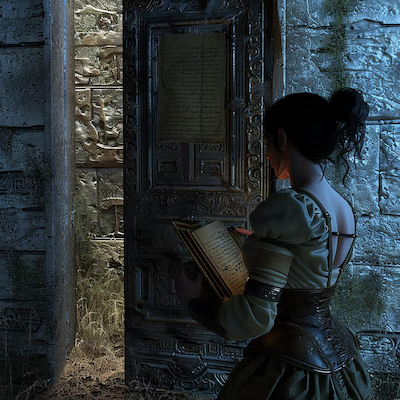
The short narrative is a literary genre that, though often underestimated, has a depth and complexity that rivals longer works. Authors such as Jorge Luis Borges and Julio Cortázar stand out in this field, using the brevity of their stories to explore universal and existential themes. Their works are true labyrinths of ideas, where the reader is invited to dive into magical realities and deep reflections on the human condition.
Borges and Cortázar, each in their own way, challenge the conventions of traditional narrative, creating worlds where time and space are fluid. Through their short narratives, they offer us a unique view of reality, filled with symbolism and metaphors that make us question the very nature of existence. In this article, we will explore how these narratives function, the benefits of delving into this literary style, and how their works reveal labyrinths and magical realities.
How Short Narratives in Borges and Cortázar Work
The short narratives of Borges and Cortázar function as an invitation to reflection and interpretation. In their works, the economy of words is not a sign of superficiality, but a resource that allows for a denser exploration of complex themes. Borges, for example, uses the structure of short stories to present philosophical ideas that challenge the logic and linearity of time. His stories often intertwine, forming a narrative fabric that seems infinite, like a labyrinth where every corner reveals a new perspective.
Cortázar, on the other hand, adopts a more experimental approach, playing with the form and structure of the narrative. He frequently breaks the linearity of time, creating stories that unfold in unexpected ways. In “The Taken House” (“Casa Tomada”), for example, the progression of the narrative is subtle but powerful, leading the reader into a growing sense of strangeness and discomfort. This breaking of expectations is one of Cortázar’s trademarks, using the short narrative as a means to explore the complexity of the human experience.
Another fundamental aspect of short narratives in Borges and Cortázar is intertextuality. Both authors make references to literary, philosophical, and historical works, creating a dialogue between their stories and the vast universe of literature. This technique not only enriches the reading but also invites the reader to become a co-author of interpretation, allowing for multiple layers of meaning. Through these connections, Borges and Cortázar establish a link between the reader and literature, transforming reading into an active experience.
The use of symbolism and allegory is a striking feature of the short narratives of these authors. Borges, for instance, often resorts to symbols such as labyrinths, mirrors, and books, which represent the search for knowledge and truth. Cortázar, in turn, uses elements of everyday life to create a magical atmosphere, where the banal becomes extraordinary. This ability to transform the ordinary into something magical is one of the traits that make their works so captivating and memorable.

Benefits of Exploring the Short Narrative in Borges and Cortázar
Exploring the short narrative in Borges and Cortázar offers several advantages that go beyond the pleasure of reading. First, these stories are an excellent gateway to literature, especially for those who feel intimidated by longer novels. The brevity of the narratives allows new readers to become familiar with the style and depth of Latin American literature without a huge time commitment.
The short narrative favors concentration and reflection. When reading a short story, the reader is led to absorb every word and nuance, resulting in an intense and rewarding reading experience. Borges and Cortázar, with their ability to create atmospheres and evoke emotions, ensure that each story is a rich and engaging journey. This intensity can stimulate discussions and reflections, enriching the individual experience and the exchange of ideas between readers.
The diversity of themes and styles both authors address in their short narratives is another point to consider. Borges, with his fascination with infinity, time, and identity, offers a range of stories that explore deep philosophical questions. Cortázar brings a more playful and experimental approach, challenging narrative conventions and allowing for a wide range of interpretations. This diversity makes reading their works a constantly new and surprising experience.
Finally, the short narrative in Borges and Cortázar serves as a reflection of Latin American literature as a whole. By exploring issues of identity, culture, and the human condition, these authors contribute to the construction of a rich and multifaceted literature. Through their narratives, they not only entertain but also educate and provoke the reader to think critically about the world around them. This combination of entertainment and reflection is one of the great advantages of delving into the short narrative of these two masters.
How Short Narratives in Borges and Cortázar Reveal Labyrinths and Magical Realities
The construction of the narrative and its symbols
Borges and Cortázar use narrative construction to create labyrinths of meaning. Every element in their stories is carefully chosen, and the symbolism that permeates their works is essential for understanding the whole. Labyrinths, mirrors, and books are not just objects but representations of the search for knowledge and truth.
The use of metaphors in fantastic fiction
Metaphors play a crucial role in the short narratives of these authors. Borges, for example, uses the metaphor of the labyrinth to represent the complexity of the human mind. Cortázar, on the other hand, frequently resorts to metaphors from everyday life to create a magical atmosphere, where the mundane becomes extraordinary.
Labyrinths as representations of the human mind
Labyrinths, present in many of Borges’ works, symbolize the complexity of the human mind and the search for self-knowledge. Every path taken within the labyrinth represents a choice, a possibility, and the reader is invited to reflect on their own choices and experiences.
Magical realities and their connection to Latin American literature
Latin American literature is rich in magical elements, and both Borges and Cortázar incorporate these realities into their narratives. Magic is not merely a decorative element but a way to explore the human condition and the relationship between the real and the fantastic.
The influence of Borges and Cortázar on contemporary literature
Both authors have left a lasting legacy in contemporary literature, influencing a generation of writers who seek to explore the short narrative and its possibilities. Their narrative and thematic innovations continue to inspire new authors, who see brevity as a way to express complexity.
The importance of the short narrative in forming new readers
The short narrative is a powerful tool in forming new readers. Borges and Cortázar’s stories are accessible and engaging, allowing beginner readers to connect with literature in a meaningful way. This connection can spark an interest in reading and encourage exploration of longer and more complex works.
This multifaceted approach to the short narrative in Borges and Cortázar reveals not only labyrinths of meaning but also the magic that permeates literature. Through their works, they invite us to explore realities beyond the ordinary, challenging us to see the world from new perspectives.

Did you enjoy discovering the short narrative in Borges and Cortázar: labyrinths and magical realities?
The short narrative in Borges and Cortázar is a fascinating journey through labyrinths and magical realities. These authors show us that, in just a few pages, it is possible to explore the complexity of the human condition and the nuances of existence. Their works are an invitation to reflection and discovery.
If you were intrigued by this literary universe, don’t hesitate to dive deeper into the works of Borges and Cortázar. Each story is a new opportunity to explore ideas and emotions, enriching your experience as a reader and expanding your literary horizons.
Frequently Asked Questions
What is the short narrative in Borges and Cortázar?
The short narrative in Borges and Cortázar explores brief stories, full of depth. They use labyrinths and magical elements to capture your attention.
What are the main themes addressed?
The most common themes are time, identity, and reality. Both authors play with your perception of the world.
How do Borges and Cortázar differ?
Borges is more philosophical and complex. Cortázar is more playful and experimental. However, both captivate with their magical narratives.
Where can I find these works?
You can find these works in physical and online bookstores. Many of them are available in digital format.
Why read these narratives?
Reading the short narrative in Borges and Cortázar: labyrinths and magical realities is a journey. You will discover new worlds and lose yourself in words!

